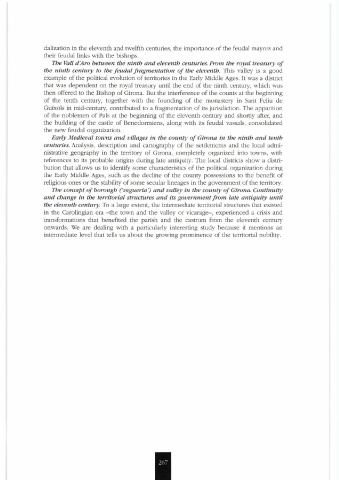Page 267 - Girona, de Carlemany al feudalisme (785-1057). El trànsit de la ciutat antiga a lèpoca medieval (II)
P. 267
dalization in the eleventh and twelfth centuries, the importance of the feudal mayors and
their feudal links with the bishops.
The Vall d'Aro between the nintb and eleventh centuries. From the royal treasury of
the nintb century to the feudal fragmentation of the eleventh. This valley is a good
example of the political evolution of territories in the Early Middle Ages. It was a district
that was dependent on the royal treasury until the end of the ninth century, which was
then offered to the Bishop of Girona. But the interference of the counts at the beginning
of the tenth century, together with the founding of the monastery in Sant Feliu de
Guíxols in mid-century, contributed to a fragmentation of its jurisdiction. The apparition
of the noblemen of Pals at the beginning of the eleventh century and shortly after, and
the building of the castle of Benedormiens, along with its feudal vassals, consolidated
the new feudal organization.
Early Medieval towns and villages in the county of Girona in the ninth and tenth
centuries. Analysis, description and cartography of the settlements and the local admi-
nistrative geography in the territory of Girona, completely organized into towns, with
references to its probable origins during late antiquity. The local districts show a distri-
bution that allows us to identify some characteristics of the political organization during
the Early Middle Ages, such as the decline of the county possessions to the benefit of
religious ones or the stability of some secular lineages in the government of the territory.
The concept of borougb (vegueria) and valley in the county of Girona. Continuity
and change in the territorial structures and its government from late antiquity until
the eleventb century. To a large extent, the intermediate territorial structures that existed
in the Carolingian era –the town and the valley or vicarage–, experienced a crisis and
transformations that benefited the parish and the castrum from the eleventh century
onwards. We are dealing with a particularly interesting study because it mentions an
intermediate level that tells us about the growing prominence of the territorial nobility.

